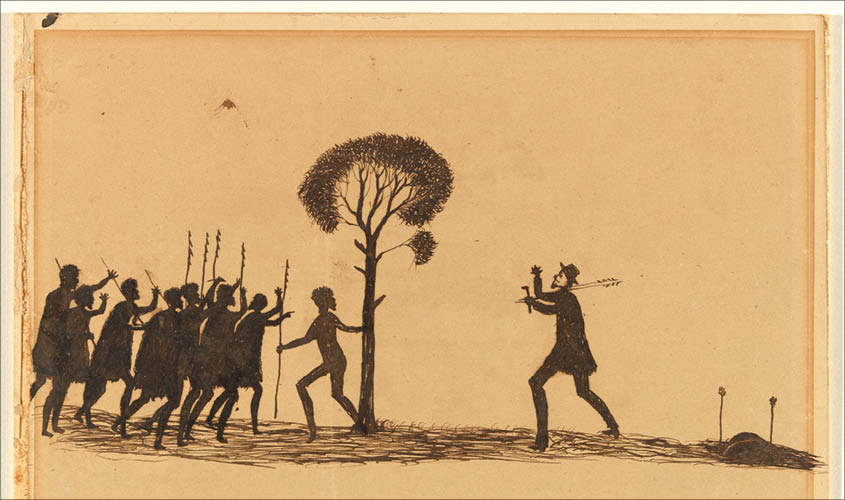The ongoing exhibition at Delhi’s NGMA features 102 artworks by Aboriginal artists from Australia, who have, over the last two centuries, developed a unique creative language to depict the plight of marginalised communities, writes Bhumika Popli.
The ambient music playing at Indigenous Australia, the exhibition on view at Delhi’s National Gallery of Modern Art, has a hypnotic charm to it. It makes you briskly walk towards its source while disregarding other exhibits in your field of view.
The source of the music is Poles Apart, a video work by the Australian artist who goes by the unusual name “r e a”. The video features the artist herself, wearing a black indigenous attire, running across a forest landscape probably destroyed by bushfire. Her expressions are full of anxiety, making you wonder what exactly the protagonist is trying to escape. The video ends with colours—red, blue and white —splashing on the artist.
R e a belongs to the Gamilaroi indigenous tribe of Australia. Her tribe is one of the many traditional communities in Australia that fell victim to colonial oppression and centuries of racial prejudice. And so, social justice and aboriginal history are themes that are part of r e a’s artistic vocabulary.

Photos: Aboriginal Artists Agency ltd.
In fact, most exhibits in this show, which features 102 artworks, could be read as critical commentary on European colonialists who arrived in Australia in 1788.
Hunting Party, by Christopher Pease, is a tongue-in-cheek response to colonisation. Through his oil-on-canvas painting, the artist has depicted a group of five armed men with their dog—the hunting party—trying to kill a snake at some Australian waterbody. The symbol of the snake is an important part of Australian myth and culture.
Pease is an indigenous artist and he is known for combining Western modes of painting with aboriginal themes—effectively using the language of the oppressor to tell the stories of the oppressed.
Danie Mellor’s Paradise in the Sun offers the European view of looking at the Aborigines. Everything is beautified in a European manner. The painting is rendered in an icy blue colour. The artwork appears depicting a fairytale-like garden with kangaroos and macaws aesthetically placed near trimmed plants. An inset within the painting depicts European ships. This indigenous artist has also used glitter and Swarovski crystals on the painting, encased in an ornate, Baroque-style frame.

These works of art bring to mind the popular phrase, “White Australia has a black history”. Also, the exhibition dutifully acknowledges Austrialia’s rich tribal heritage. “The Indigenous artists represented here come from specific regional blocs: Arnhem Land and its environs in the Northern Territory, and the western deserts and the Kimberley in Western Australia. In addition, many artists hail from the eastern, western and southern seaboards where their ancestors experienced the initial force of colonisation at the cost of many lives, and of many cultural traits,” records the show’s curator, Franchesca Cubillo, in her catalogue essay. According to her, these “artist descendants” are presenting their realities which were not included in the official histories of Australia.
The indigenous culture of Australia goes back to nearly 60,000 to 80,000 years. This is the art of land where tribes painting on rocks as well as on the bodies of people living in their community. Their art consists of etchings and ceremonial designs. The Aborigines extensively used symbols to communicate to make up for the lack of a written language. The colours for the paintings were taken from the nature itself. Australian Aboriginal art is established as evidence of the longest surviving culture in human history. There are many styles that differ from region to region. One of the prominent styles is the aerial view representation. The present show contains some striking examples of that: Bush Plum Country, a vibrantly coloured painting representing the Australian landscape; and Canyon, a golden view of a river, by Judy Watson.
The 102 exhibits displayed here, some dating back to the late 1800s while others of a more recent vintage, are sourced from the collection of the National Gallery of Australia.
Among the older works, the theme of colonisation has a very stark presence. One drawing, entitled Meeting the White Man, depicts a group of Aborigines protecting a tree from being felled by a foreigner. Another drawing represents a Melbourne tribe performing corroboree, an Australian dance ceremony, after seeing ships for the first time. Both the drawings, by Tommy McRae, are believed to have been created around 1890.
Another striking feature of the show is the series of bark paintings, which were produced around the Arnhem Land area. These painters depicted their local stories, and used natural pigments on eucalyptus barks. The paintings show kangaroos and serpents, humans and spirits—emblems of man’s bond with nature.
‘Indigenous Australia: Masterworks from the National Gallery of Australia’ is on view at Delhi’s National Gallery of Modern Art till 26 August

